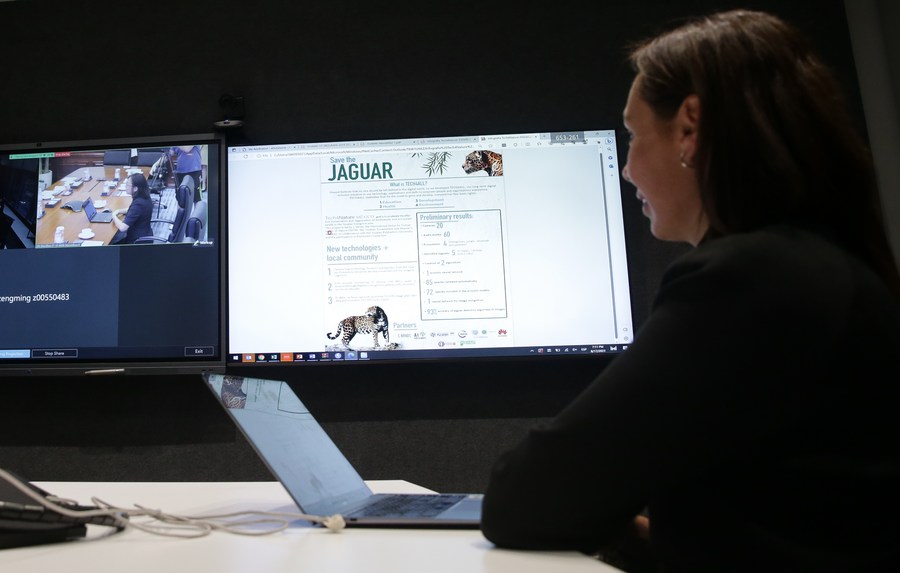* The "cloud" isn't the one hanging up in the sky. It is in fact cloud technology, which has been applied to wildlife conservation in Latin America.
* With cloud technology, technicians and ecologists from China and its trans-Pacific partners have been able to work hand in hand under the Belt and Road Initiative to protect endangered species and their habitats in Latin America.
* This cooperation has sowed the seeds of hope for a better future.
by Xinhua writers Chen Yao, Wu Hao and Ma Xiaocheng
GUANGZHOU/MEXICO CITY, Sept. 3 (Xinhua) -- Only a "cloud" away is how residents at the Dzilam State Reserve in Mexico think of the distance between Latin America and China, despite their geographical farness.
The "cloud" isn't the one hanging up in the sky. What the residents refer to is in fact cloud technology, which has been applied to wildlife conservation not only in this Mexican reserve, but also in Chile, Costa Rica and other Latin American countries.
In recent years, with cloud technology, technicians and ecologists from China and its trans-Pacific partners have been able to work hand in hand under the Belt and Road Initiative to protect endangered species and their habitats in Latin America. This cooperation has, as many locals in the region said, sowed the seeds of hope in their hearts for a better future.
TRACKING ENDANGERED ANIMALS
The Dzilam State Reserve, located in the municipalities of Dzilam de Bravo and San Felipe in the Yucatan Peninsula, is nestled amongst lush green vegetation.
"This entire land was the jaguars' home. I have liked this animal since my childhood. I knew that the jaguar was part of us," said Juan Castillo, a community leader of Dzilam de Bravo.
Home to many endemic and endangered species in Mexico, the area, known for its biodiversity-rich habitats, has started to witness ecosystem degradation over the years due to human activities and climate change. In 2002, jaguar, the only big cat left in the reserve, was listed as Near Threatened in the International Union for Conservation of Nature (IUCN) Red List of Threatened Species.
Local communities and environmentalists have tried to track the habitat of jaguars, but have found it rather difficult: These animals are often hidden in vast forests or tropical rainforests, rarely leaving unmistakable traces, making it hard to observe them under natural conditions. Besides, the odds of real-time monitoring of illegal hunting and poaching are also quite low.
A similar situation also befell Darwin's fox in Chile.
In the eyes of Bernardo Reyes, director of Chilean environment organization Etica en los Bosques (Forest Ethics), Nahuelbuta, a biodiversity hotspot in Chile, is not only a treasure trove of original forests, but also a paradise for world zoologists searching for the footprints of puma, skunk, Chilean deer and Darwin's fox.
However, a few years ago, Reyes started to worry about the protection and study of Darwin's fox, a highly ecologically valuable umbrella species, whose protection, if secured, would also protect other species.

Samira Herrera, Huawei Mexico Communications and Public Relations manager, talks via video with Zeng Ming, TECH4ALL project manager of Huawei, in Mexico City, Mexico, Aug. 17, 2023. (Photo by Francisco Canedo/Xinhua)
PROTECTING BIODIVERSITY
To better protect wild animals and biodiversity, the Tech4Nature Mexico project was launched in the Dzilam reserve by the government of Yucatan, IUCN, China's tech giant Huawei, C Minds, Rainforest Connection (RFCx) and other organizations.
The project collects video data from cameras recording 24 hours a day in the Dzilam State Reserve to monitor the biodiversity of the area and use acoustic technology to understand the existence of species and the health of ecosystems.
Zeng Ming, TECH4ALL project manager of Huawei in the southern Chinese city of Shenzhen, said using key technologies to process tens of thousands of hours of audio and video can capture useful content in just a few hours, with an average analysis accuracy of 96 percent.
Zeng added that they provide online and face-to-face training for locals, which helps improve work efficiency.
Regina Cervera, Tech4Nature coordinator at C Minds in Mexico, said that once the staff installed cameras and left, no one would enter or disturb the area during the period.
After 40 days, the staff returned, took out the camera storage card and uploaded the images and video files to Huawei Cloud for further analysis.
In recent years, Chile and Costa Rica have also conducted similar coordination under this project.
In Chile, the project provides an ecological acoustic monitoring platform that utilizes Huawei's cloud and artificial intelligence (AI) technology to support the environmental protection work of the RFCx organization.
RFCx's research team would use Huawei's AI model to identify the areas where Darwin's foxes appear by identifying sounds, studying their living habits and developing management plans to protect the species.
In addition, Reyes explained that if a threat is detected, the system will issue a real-time alarm and send the location of logging and poaching via an app to the phones of local forest rangers to help them quickly intervene on site.

Zeng Ming, TECH4ALL project manager of Huawei, talks via video with Samira Herrera, Huawei Mexico Communications and Public Relations manager, in Shenzhen, south China's Guangdong Province, Aug. 18, 2023. (Xinhua/Cheng Chixiang)
SOWING HOPES
Omelia Trejo, a resident of the Dzilam de Bravo community, said their dream is "protecting jaguars for a lifetime," but they worried that in the future, children might only see jaguars in photos. "Thanks to this project, our dream has come true."
From September 2022 to May 2023, local experts, with the help of Huawei Cloud, have identified 119 species in the Dzilam reserve, including 88 species of birds, 22 species of mammals, five species of reptiles and four species of amphibians, of which 34 species are on the IUCN Red List of Threatened Species. They have also spotted at least five jaguars in the reserve.
According to Zeng, Huawei has implemented Tech4Nature projects in 46 protected areas on four continents, utilizing digital technology to protect their iconic ecosystems such as forests, wetlands, and oceans.
"I hope to collaborate with more partners to fully leverage the empowering role of technology and protect our homeland of Earth together," Zeng said.
The Tech4Nature project is a component of the Belt and Road cooperation between China and Latin America, which aims to sow the seeds of hope for a better future in the hearts of many people.
"I hope that in 30 or 50 years, the jungle as we know will continue to exist and that we have these sanctuaries where life will continue to exist, prosper and develop," Cervera said. "I am still a bit optimistic."
(Wang Pan and Liang Xizhi in Shenzhen, Zhu Yubo in Santiago also contributed to the story.)
(Video reporters: Chen Yao, Wu Hao, Ma Xiaocheng, Liang Xizhi; Video editors: Hong Ling, Zheng Qingbin, Zhang Nan, Zhou Yang, Hong Yan.)■











